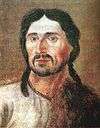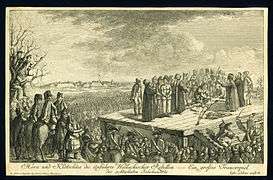Revolt of Horea, Cloșca and Crișan
The Revolt of Horea, Cloșca and Crișan (31 October 1784 – 14 December 1784) began in the Metaliferi Mountains, Transylvania, but it soon spread throughout all Transylvania and the Apuseni Mountains.



The leaders were Horea (Vasile Ursu Nicola, 1731–1785), Cloșca (Ion Oargă, 1747–1785) and Crișan (Marcu Giurgiu, 1733–1785). The revolt was directly related to the poor level of the feudal serfdom in Transylvania and though the Orthodox Romanians lacked of political equality contrary to the Catholic nations of Transylvania, the events were not necessarily motivated by ethnic tensions.
After Leopold I, Holy Roman Emperor's incorporation of the principality into the Habsburg domains in 1691, the rights of the Hungarian, Székely and Saxon nobles were preserved. The peasants however, still had no representation in politics. Especially the Romanian peasantry had no guarantees for their Orthodox church institutions, though they were tolerated. As mouthpiece for the Romanian peasants, Horea – whose official name was Vasile Ursu Nicola – traveled to Vienna often in the years from 1779 to 1782 to explain the hardships of the Transylvanian peasantry and lack of representation, without any result. The trigger of the events was started on 31 January 1784 when Joseph II, Holy Roman Emperor issued an order to increase the number of the border guards of Transylvania, many people from many villages assembled in Karlsburg (Gyulafehérvár, Alba Iulia) to enroll in the army as an option to live better instead of the obligatory labor system to their landlords. Most of them were Romanian peasants. The local authorities tried to slow down the process assuming the Gubernium got around and did not involve them. The people interpreted this action as the "nobility" is opposing their chance for a better fate. Horea started to spread a rumor that Joseph II appointed him to the leader of the Romanians who wished to enroll into service, while Crișan called the serfs to revolt in the surrounding areas of the Fehér-Kőrös river. Therefore, more ten-thousand people united against the "nobility" who in their eyes were the oppressors imposing high taxes on them. Shortly, the tensions culminated into a revolt, targeting the nobles and the non-Orthodox common people (regardless of ethnicity). The massacres mostly affected the areas and population of Alsó-Fehér County, Zaránd County and Hunyad County. Between the autumn of 1784 and the winter up to 1785, civilian casulties were about 4,000 people from 133 settlements, mostly Hungarians.
As long as the Gubernium and the military leadership debated about a possible intervention – awaiting the order from Vienna, the Hungarian nobility organized its defence, they trialed in Déva (Deva) and executed 56 captured peasants.[1]
.png)
As Joseph II ordered the army to intervene, the uprising was ended by Horea on 14 December 1784, at Topesdorf (Hungarian: Topánfalva, Romanian: Câmpeni). Afterwards, in January 1785, the leaders were captured by treason. From the more than 600 captured rebels, 120 were sentenced; 37 death penalties were delivered initially but they were changed to imprisonment as a result of the amnesty of the emperor, with an exception regarding the three leaders.[1][2] Horea and Cloșca were executed by the Hungarian authorities by breaking on the wheel on 28 February 1785 at Dealul Furcilor (Gabelberg, Forks Hill), Alba Iulia (Gyulafehérvár). Crișan hanged himself on the night before the execution. After the protest had been put down Joseph II responded by enacting a Patent for the Abolition of Serfdom for Transylvania in 1785. The uprising reverberated throughout western Europe.
 The execution of Horea and Cloșca
The execution of Horea and Cloșca The wooden church in Horea's village
The wooden church in Horea's village
References
- "Kitör a Horea és Cloşca vezette felkelés". www.mult-kor.hu.
A Gubernium és a főhadparancsnokság egymással vitázott; Bécsből vártak utasítást. Közben a vármegyei nemesség megszervezte önvédelmét, Dévánál kisebb győzelmet aratott a felkelők fölött, 56 elfogott parasztot kivégeztek.
- Tamás, Tarján M. "The execution of Horea and Closca in Alba Iulia". www.rubicon.hu.
Sources
- Pascu, Ștefan (1984). Revoluția populară de sub conducerea lui Horea. București: Editura Militară. p. 534.
- http://www.rubicon.hu/magyar/oldalak/1785_februar_28_horea_es_closca_kivegzese_gyulafehervaron/
- http://mek.oszk.hu/03400/03407/html/322.html
- http://www.executedtoday.com/2017/02/28/1785-horea-and-closca-transylvanian-rebels/
The definitive work on this topic is David Prodan, Rascoala lui Horea. Bucharest: Editura Stiintifica si Enciclopedica, 2 vols, 1979.
External links
| Wikimedia Commons has media related to Horea, Cloșca and Crișan. |